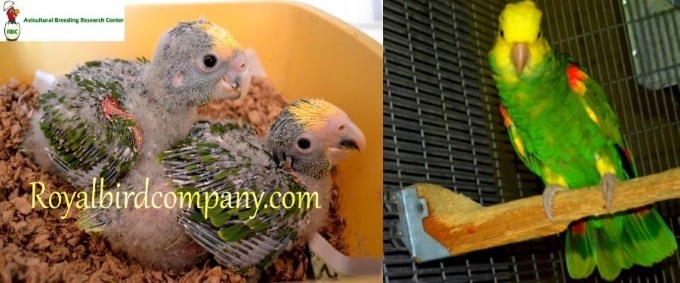Double Yellow Head Amazon
genus Amazona ochrocephala oratrix & (magna)
Description: There are 2
available distinct known variables in this species.
One of the most sold amazon parrots in the USA, the
Amazona ochrocephala oratrix, this species is what you find
most times when offered baby double yellow head amazons,
with little or no yellow and red in bend of the wings and
when young just the forehead and crown is yellow, with the
entire head being covered in yellow in few years. Double
Yellow Head Amazons are native from
The other geo different subspecies although
sometimes not recognized as separate species is the Magna or
eastern double yellow headed amazon subspecies Amazon
ochrocephala (magna), being uncommon and the most
colorful with the head being covered more at a earlier age,
many get full yellow much sooner than the oratrix. Our magna
babies will even have yellow around their eyes and yellow
going down into their chest area when only few months old,
which is totally distinctive of the magna species. The wings
have the yellow and red in the bends and also under the
wings at the bend and where it joins the body, even when
very young you can see this. We see the yellow leg stockings
very early.
Also one other distinct thing is the full yellow
stockings on the legs on adult birds, where the oratrix have some yellow on
the lower leg but not as noted or seen. The magna will be
seen mostly as a stocky built bird compared to the nominate
form oratrix which is seen as a more streamlined built bird.
The magna is sometimes called the eastern double
yellow head in some books on amazons and by some experts
such as Tony Silva. The magna double yellow head can be
found only in the eastern areas on the Caribbean slopes of
The other not so common species and vertually non
existent in the USA of Double yellow
head is the birds from the western islands in the Pacific
area of
Our facility has owned and still own many many real
magna pairs I have only seen and owned one pair of real tres
marie Double Yellow Head Amazon, although I have responded
to many adverts that claimed to have them, in which when I
saw them was do doubt subspecies Magnas, I think that many
breeders and owners mistakenly think that the tres marie is
this very colorful bird, infact many may not be as colorful
as some of the magna,and have a totally different edge on
the feathering, where this edging does not exist on the tres
marie specimens. Again when someone actually sees the real
thing it cannot ever be confused with anything else. If you
have an eye for detail you can see the difference in the
species.
The pair of Tres Marie we owned were brought as long term pets from the island in the 70's by a person that lived there and i purchased them and like a fool I sold them soon after, as the offer that we got was too hard to refuse back then. The 2 species are far different from each other and by any eye with detail the species cannot be confused with one or the other.
To regress, The magna sub species is from the
eastern area of
The Amazona species called Double Hellow Head Amazon in general is well known for talking ability. The Double Yellow Head Amazon is one of the more colorful species of amazons. Talking here about the nominate species Oratrix, When young there is much less yellow on the head and as the bird matures ( can take 20-30 years) the yellow completely covers the crown and some may have yellow down into the face as well. As with all amazons the Yellow heads do have their own little quirks and attitudes. I think that most attitudes as well as mature personality is formed while still young.
Our babies are handled and given every opportunity
to become a very well socialized bird. Many babies have many
different colorations when young, we have had babies with
yellow faces and some with just the crown being yellow when
babies. When all Yellow heads start to mature the head as
well the cheeks start to get yellow until all the crown,
head, cheeks and around the eyes have yellow covering, The
name Double Yellow Head comes from this coloring.
I personally love this species due to the coloring
and demeanor. I just love amazons in general. They may not
be for everyone, You just has to love them for who and what
they are and accept all the amazon attitudes as we many times do
with our fellow human beings.















